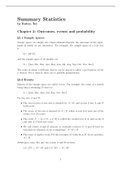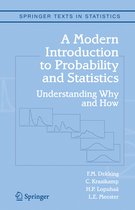Summary Statistics
by Ruben Tol
Chapter 2: Outcomes, events and probability
§2.1 Sample spaces
Sample spaces are simply sets whose elements describe the outcomes of the exper-
iment in which we are interested. For example, the sample space of a coin toss
is
Ω = {H, T },
and the sample space of all months are
Ω = {Jan, Feb, Mar, Apr, May, Jun, Jul, Aug, Sep, Oct, Nov, Dec}.
The order in which n different objects can be placed is called a permutation of the
n objects. For n objects, there are n! possible permutations.
§2.2 Events
Subsets of the sample space are called events. For example, the event of a month
being long (containing 31 days) is
L = {Jan, Mar, May, Jul, Aug, Oct, Dec}.
For two sets A and B:
• The intersection of two sets is denoted by A ∩ B, and occurs if two A and B
both occur.
• The union of two sets is denoted by A ∪ B, which occurs if at least one of the
events A or B occurs.
• The event Ac = {ω ∈ Ω : ω ∈/ A} is called the complement of A, and occurs if
and only if A does not occur.
• We call events A and B disjoint or mutually exclusive if A and B have no
outcomes in common; in set terminology: A ∩ B = ∅
• The event A implies event B if the outcomes of A also lie in B. In set notation:
A ⊂ B.
DeMorgan’s laws. For any two events A and B we have
(A ∪ B)c = Ac ∩ B c and (A ∩ B)c = Ac ∪ B c .
1
,§2.3 Probability
A probability function P on a finite sample space Ω assigns to each event A in Ω a
number P(A) in [0, 1] such that P(Ω) = 1 and P(A ∪ B) = P(A) + P(B) if A and B
are disjoint. The number P(A) is called the probability that A occurs.
To compute probabilities of events A and B that are not disjoint, we can use
P(A) = P(A ∩ B) + P(A ∩ B c ) and P(A ∪ B) = P(B) + P(A ∩ B c ).
Combining these equations yields the probability of a union: for any two events A
and B we have
P(A ∪ B) = P(A) + P(B) − P(A ∩ B).
For computing probabilities of complements of events, since A ∪ Ac = Ω, we deduce
that
P(Ac ) = 1 − P(A).
Chapter 3: Conditional probability and indepen-
dence
§3.1 Conditional probability
The conditional probability of A given C is given by
P(A ∩ C)
P(A|C)) = ,
P(C)
provided P(C) > 0.
§3.2 The multiplication rule
The multiplication rule. For any events A and C:
P(A ∩ C) = P(A|C) · P(C).
§3.3 The law of total probability and Bayes’ rule
The law of total probability. Suppose C1 , C2 , . . . , Cm are disjoint events such that
C1 ∪ C2 ∪ · · · ∪ Cm = Ω. The probability of an arbitrary event A can be expressed
as
P(A) = P(A|C1 )P(C1 ) + P(A|C2 )P(C2 ) + · · · + P(A|Cm )P(Cm ).
Bayes’ rule. Suppose the events C1 , C2 , . . . , Cm are disjoint and C1 ∪ C2 ∪ · · · ∪ Cm =
Ω. The conditional probability of Ci , given an arbitrary event A, can be expressed
as:
P(A|Ci ) · P(Ci )
P(Ci |A) = .
P(A)
2
, §3.4 Independence
An event A is called independent of B if
P(A|B) = P(A).
Independence. To show that A and B are independent it suffices to prove just one
of the following:
• P(A|B) = P(A),
• P(B|A) = P(B),
• P(A ∩ B) = P(A)P(B),
where A may be replaced by Ac and B replaced by B c , or both. If one of these
statements holds, all of them are true. If two events are not independent, they are
called dependent.
Independence of two or more events. Events A1 , A2 , . . . , Am are called independent
if
P(A1 ∩ A2 ∩ · · · ∩ Am ) = P(A1 )P(A2 ) . . . P(Am )
and this statement also holds when any number of the events A1 , . . . Am are replaced
by their complements Ac1 , . . . Acm throughout the formula.
Chapter 4: Discrete random variables
§4.1 Random variables
Let Ω be a sample space. A discrete random variable is a function X : Ω → R
that takes on a finite number of values a1 , a2 , . . . , an or an infinite number of values
a1 , a2 , . . . .
§4.2 The probability distribution of a discrete random vari-
able
The probability mass function p of a discrete random variable X is the function
p : R → [0, 1], defined by
p(a) = P(X = a) for − ∞ < a < ∞.
The distribution function F of a random variable X is the function F : R → [0, 1],
defined by
F (a) = P(X ≤ a) for − ∞ < a < ∞.
3






